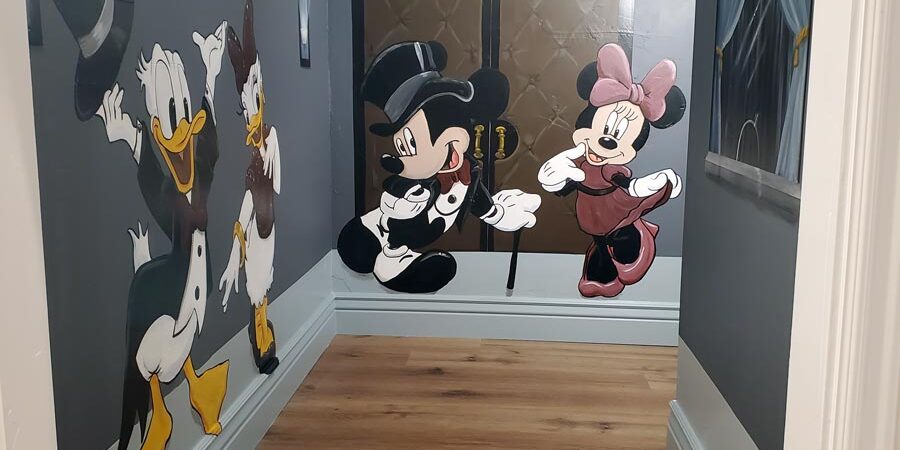Below, we’ve rounded up 10 stunning home theater ideas to help you create the ultimate entertainment escape right beneath your feet.
Why Basements Are Perfect for Home Theaters
Before diving into design, it’s worth understanding why basements make ideal home theaters. They’re naturally quiet, separate from the main living areas, and easier to soundproof. They also give you total control over lighting — no sunlight glare interrupting your favorite scenes.
| Advantage | Impact |
|---|---|
| Sound Control | Concrete walls and below-grade structure naturally block noise, creating a true cinema experience. |
| Lighting Control | No windows = no glare. You can use ambient and accent lighting to set the perfect viewing mood. |
| Privacy | Separate from main living areas, so you can enjoy late-night movies or sports without disturbing anyone. |
| Added Home Value | Basement finishing projects that include media rooms or theaters can yield high ROI and appeal to modern buyers. |
1. The Classic Cinema Experience
If you want that authentic movie theater feel, this design is for you. Think plush recliners, wall sconces, a projection screen, and deep, dramatic colors that make the screen pop. Basements are ideal for this setup because they let you go all-in on ambiance without worrying about daylight interference.
- Opt for tiered seating: Elevated platforms ensure everyone gets a perfect view.
- Install dimmable wall sconces: Adds cinematic drama while keeping the room functional between shows.
- Choose dark finishes: Matte navy, charcoal, or espresso walls reduce light reflection.
Pro Tip: Add acoustic wall panels that mimic vintage theater drapery for both style and sound control.
2. The Modern Minimalist Theater
For a sleek, design-forward look, the minimalist theater focuses on clean lines, high-tech gear, and a clutter-free vibe. It’s perfect for contemporary homes that want entertainment to feel like an extension of the main living space.
- Hidden speakers and wiring: Use in-wall or in-ceiling sound systems for a streamlined appearance.
- Monochrome palette: Shades of black, white, and gray keep things sophisticated.
- Floating shelves and recessed lighting: Add function without visual noise.
Pro Tip: A motorized drop-down projector and retractable screen give you flexibility between movie mode and open space.
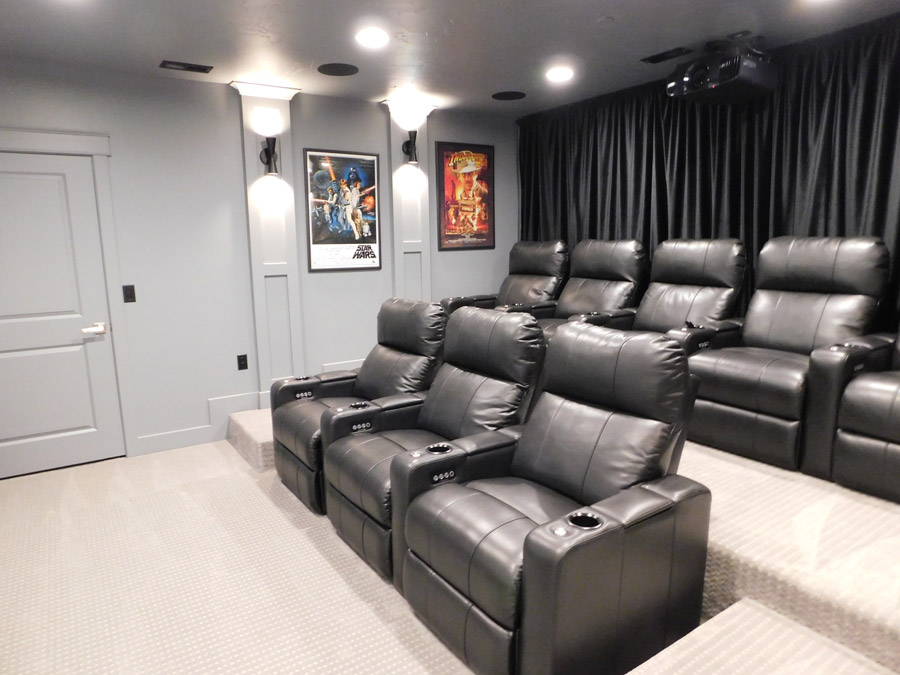
3. The Family Movie Zone
Not every home theater has to feel formal. Family theaters are about comfort, laughter, and flexibility. Picture oversized sectionals, soft throws, and enough floor space for kids to sprawl out during movie marathons.
- Use cozy materials: Think plush carpeting, bean bags, and oversized sofas.
- Include storage: Built-in cubbies or ottomans for blankets and snacks keep things tidy.
- Set up multiple viewing zones: Add a smaller TV or gaming corner for versatility.
Pro Tip: Consider washable wall paints and durable flooring — popcorn accidents happen.
4. The Luxury Lounge Theater
If your goal is high-end indulgence, this design brings the private screening room experience home. Rich materials, mood lighting, and high-end finishes make it feel like a resort-level retreat.
- Layer lighting: Combine recessed LEDs, cove lighting, and sconces for an elegant glow.
- Premium finishes: Leather recliners, walnut paneling, and custom millwork elevate the look.
- Add a bar or snack station: Marble or quartz counters make the perfect refreshment zone.
Pro Tip: Integrate a custom built-in mini fridge or popcorn machine nook for convenience and class.
5. The Gaming + Streaming Hybrid Setup
Why stop at movies? Combine your home theater with a gaming and streaming zone for the ultimate entertainment hub. Perfect for households that enjoy both cinematic and interactive fun.
- Use modular seating: Sectionals or chairs on casters let you rearrange for movie nights or gaming marathons.
- Install LED backlighting: Behind screens or shelving for an immersive glow.
- Ensure strong connectivity: Hardwire your Ethernet for lag-free online gaming.
Pro Tip: Acoustic panels double as décor — choose designs that reflect your favorite games or movie genres.
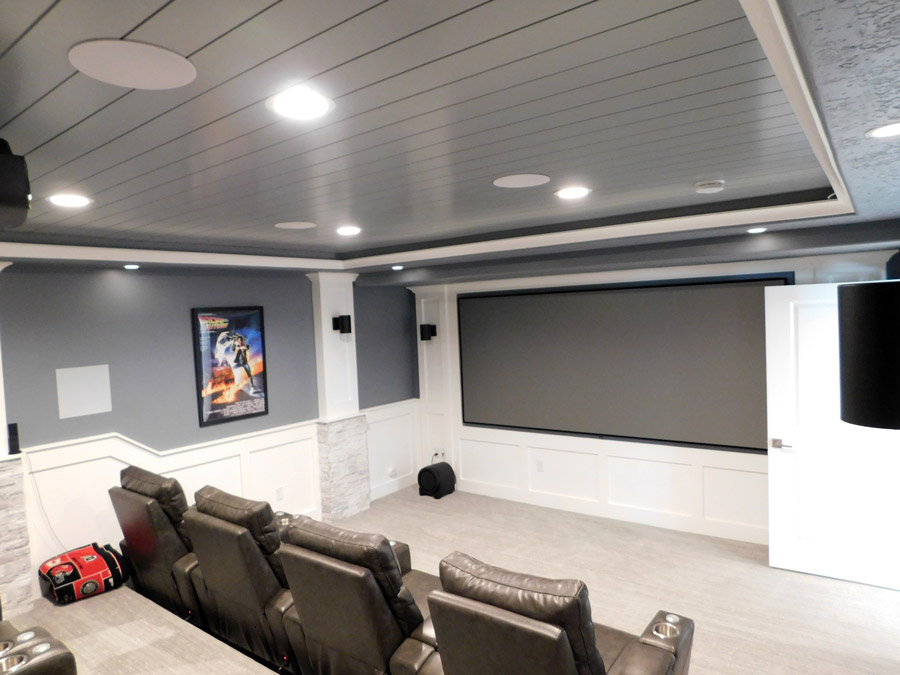
6. The Small-Space Theater Nook
Even if you don’t have a massive basement, you can still enjoy a cinematic experience. This design is all about maximizing space without sacrificing comfort or quality.
- Use a short-throw projector: Perfect for smaller rooms where space is tight.
- Opt for wall-mounted speakers: Saves valuable floor area.
- Neutral tones + mirrors: Visually expand compact spaces while keeping things cozy.
Pro Tip: Combine your theater nook with a guest suite or game zone for flexible functionality.
7. The Soundproof Powerhouse
Soundproofing is the secret sauce of every great home theater. Whether you’re blasting action movies or hosting a late-night binge session, proper acoustics make all the difference — and basements are naturally halfway there.
- Add acoustic drywall or MLV (mass-loaded vinyl): Blocks airborne sound effectively.
- Use rockwool insulation: Great for both noise and moisture resistance.
- Seal every gap: Around doors, outlets, and trim for total sound control.
Pro Tip: Install a solid-core door — it’s one of the simplest yet most impactful sound upgrades you can make.
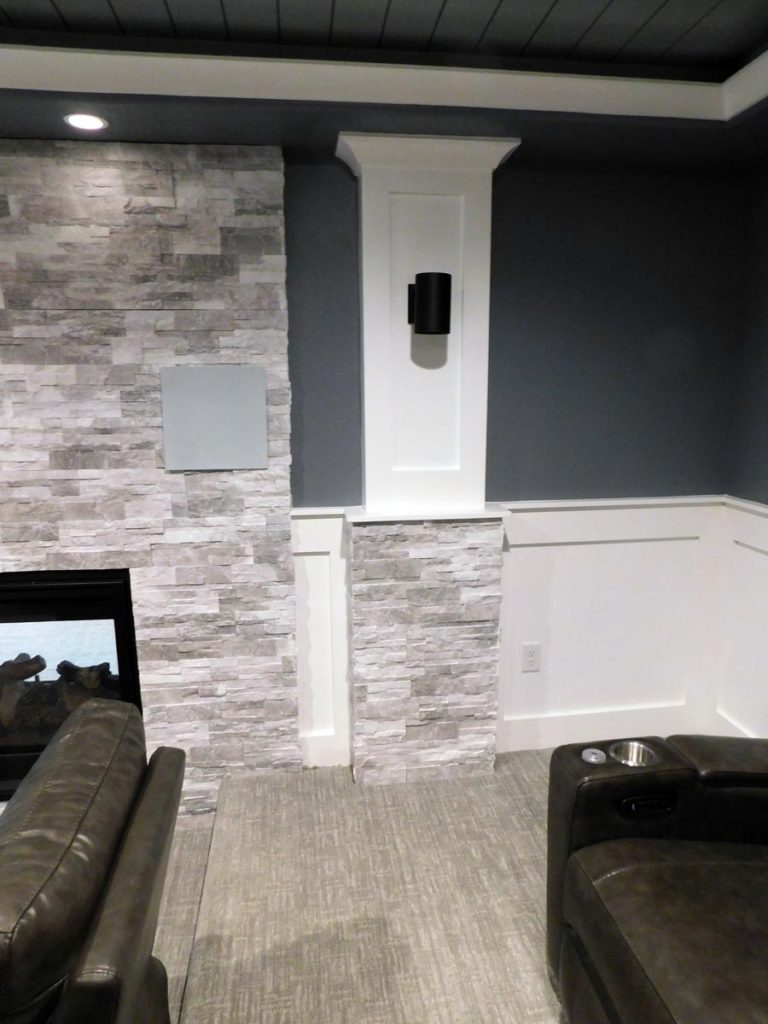
8. The Smart-Tech Theater
Modern home theaters are powered by smart technology. From voice-controlled lights to automated curtains, today’s tech can make your entertainment experience seamless.
- Automate lighting scenes: “Movie Mode” dims lights and lowers shades instantly.
- Voice or app control: Manage sound, lights, and temperature from your phone.
- Upgrade your network: A wired connection ensures uninterrupted 4K streaming.
Pro Tip: Combine smart lighting with motion sensors so ambient lights fade on when the movie ends.
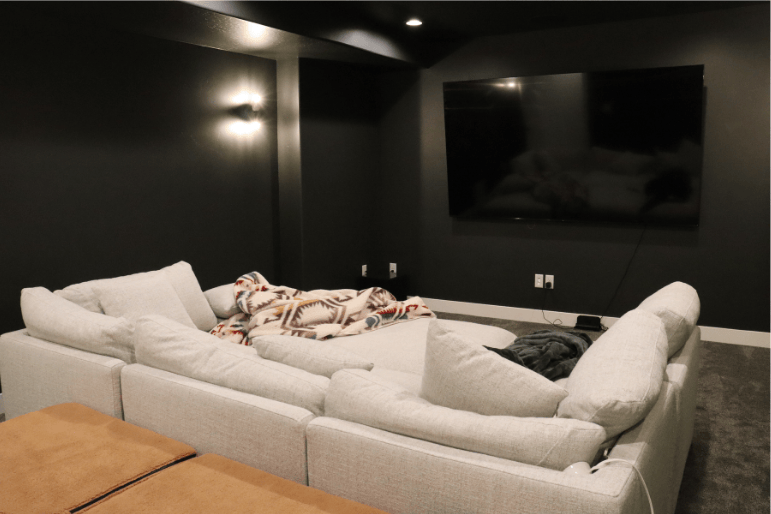
9. The Vintage-Inspired Media Room
Love the nostalgia of old Hollywood? A vintage-inspired media room brings timeless charm to modern functionality. It’s all about blending classic details with cutting-edge performance.
- Choose warm lighting: Edison bulbs and brass sconces set a nostalgic tone.
- Add décor with character: Framed movie posters, velvet curtains, and retro signage.
- Use rich color schemes: Burgundy, navy, and gold instantly evoke that theater magic.
Pro Tip: Integrate hidden modern tech — wireless subwoofers, projectors, or 4K TVs disguised behind sliding panels.
10. The Multi-Use Entertainment Suite
Why stop at a single function? This design turns your basement into a full-blown entertainment hub — combining a home theater with a game area, bar, or lounge space. Perfect for hosting, relaxing, and entertaining without ever leaving home.
- Open-concept layout: Define zones using furniture, lighting, or partial walls.
- Durable finishes: Vinyl planks, sound-absorbing ceiling panels, and stain-resistant fabrics handle parties and movie nights alike.
- Integrated lighting zones: Let you set different moods across areas.
Pro Tip: Add sound separation between the theater and bar zone to keep movie nights immersive and social time lively.
Home Theater Remodel Cost Breakdown
So, what does it cost to create a home theater that looks and sounds amazing? Prices vary depending on size, finishes, and tech level. According to HomeAdvisor, most homeowners spend between $10,000 and $45,000 for a complete home theater remodel, though luxury builds can exceed $75,000.
| Feature | Average Cost (USD) | Notes |
|---|---|---|
| Framing, Insulation, and Drywall | $25 – $60 per sq ft | Depends on whether you’re finishing an unfinished basement. |
| Acoustic Treatments | $1,500 – $5,000 | Includes insulation, panels, and soundproof doors. |
| Electrical and Lighting | $2,000 – $6,000 | Includes recessed lighting, sconces, and smart control wiring. |
| Audio/Visual Equipment | $4,000 – $15,000+ | Projector, screen, speakers, receiver, and streaming devices. |
| Seating and Furniture | $3,000 – $10,000 | From standard recliners to custom tiered seating. |
| Finishes and Décor | $2,500 – $7,000 | Includes flooring, paint, wall coverings, and cabinetry. |
| Total Estimated Investment | $15,000 – $75,000+ | Varies by tech level, room size, and finish quality. |
Remodeling Tips Before You Start
- Plan for sound first: Add insulation and resilient channels before drywall to prevent costly rework later.
- Choose basement-safe materials: Moisture-resistant drywall and vinyl flooring handle humidity best.
- Map your lighting: Use dimmable zones for cinematic control.
- Run conduit for future upgrades: Technology evolves fast — pre-run wires for tomorrow’s gear.
- Ventilation matters: Add HVAC or a mini-split system to prevent stuffiness during long viewing sessions.
- Check local permits: Electrical, framing, and soundproofing upgrades often require inspection.
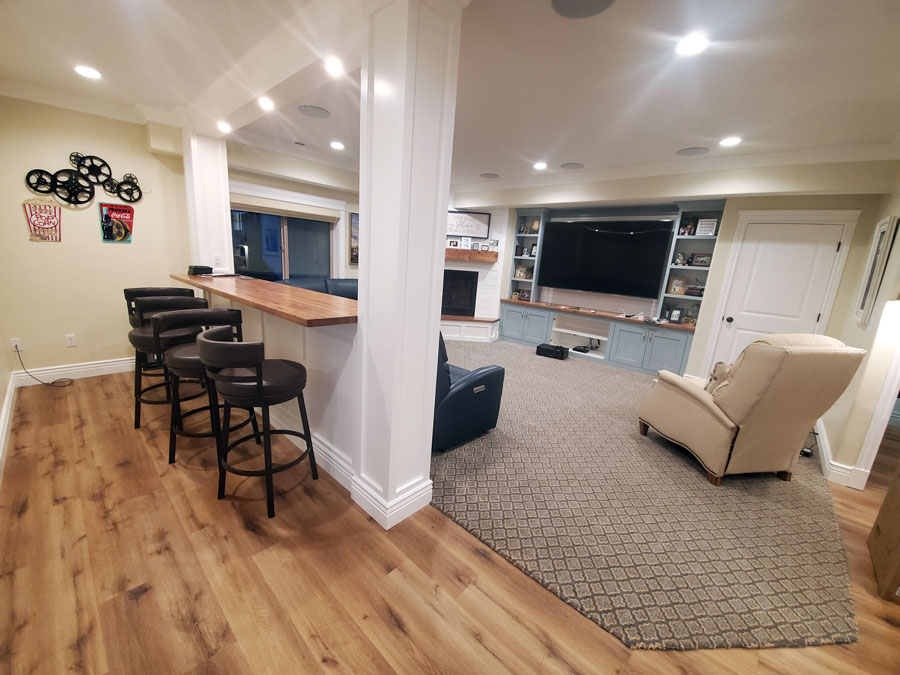
Bring Your Dream Theater to Life
From blockbuster movie nights to family game marathons, a basement home theater brings people together like nothing else. When designed right, it’s not just a room — it’s an experience.
Whether you’re in California, Colorado, or Utah, the possibilities are endless. Pro Worx Construction specializes in home theater remodels, basement finishing, and full home renovations that turn everyday spaces into extraordinary escapes.
We handle everything — from soundproofing and wiring to lighting, cabinetry, and seating — so all you have to do is grab the popcorn.
Get a Free Quote from Pro Worx Construction
Your dream theater isn’t in a mall — it’s waiting downstairs. Let’s make it happen.
Frequently Asked Questions
How much does a home theater remodel cost?
Most home theater remodels range between $15,000 and $75,000 depending on size, finishes, and tech level. Basements usually cost less to soundproof and customize than above-ground rooms.
Do I need a permit for a basement home theater?
Yes — permits are typically required for electrical work, framing, or major soundproofing. Always check your local building codes before starting.
What’s the best lighting setup for a home theater?
Layered lighting is ideal — recessed ceiling lights for general illumination, sconces for ambiance, and LED strips behind furniture or screens for depth.
Can I turn a small basement into a home theater?
Absolutely. With short-throw projectors, compact speakers, and space-saving seating, even small basements can feel like private cinemas.
What are the key design elements for great sound?
Insulation, sealed doors, carpet or acoustic flooring, and balanced speaker placement are all essential for top-tier sound quality.
Additional Resources:
Top 10 Basement Renovation Ideas
Cost to Finish a Basement in Utah


